 |
surfresearch.com.au
surfers
: bob mctavish
|
Bob McTavish
(14 May 1944 - )
| home | catalogue | history | references | appendix |
 |
surfresearch.com.au
surfers
: bob mctavish
|
|
Home: Mackay, Queensland
Beach : Gold Coast, Queensland Competitive Record Queensland Champion 1966? Duke entrant 1967 (in place of Nat Young) Surfing surfer, shaper, designer, writer, philosopher, windsurfer, Shaping Joe Larkin Surfboards, Qld Scott Dillon Surfboards, Brookvale 1962 Hohnesse Surfboards, Qld Cord Surfboards, Qld Keyo Surfboards, Brookvale 1965 -1967 Morey
- Pope Surfboards (USA)1968
San
Juan Surfboards, Byron Bay 1968
Bare NatureSurfboards, Byron Bay 1968. Dale Surfboards, 73 Winbourne Road Brookvale 934965 1968. Bob McTavish
: Angourie, 1965.
Surfing World, Volume 7 Number 4, February 1966. |
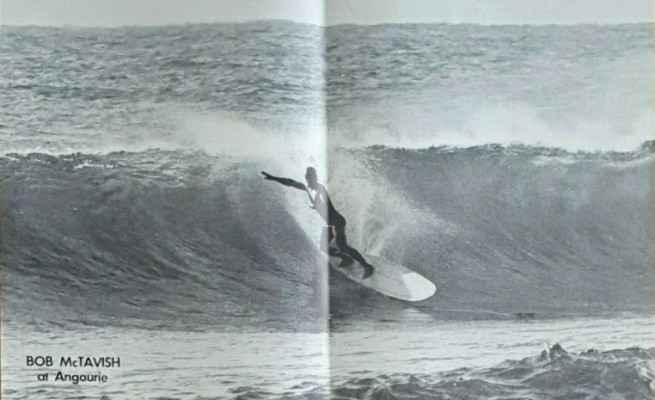 |
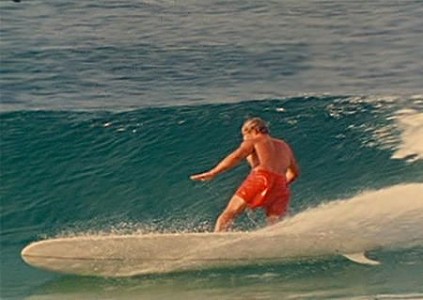 Bob McTavish, Main Beach Byron Bay, 1966. Still
from Paul Witzig's Hot Generation.
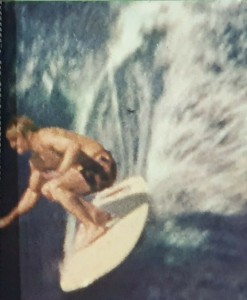 Bob
McTavish, Maui, 1967.
Still from The Fantastic Plastic Machine. Surf International, Volume 1 Number 11, see. |
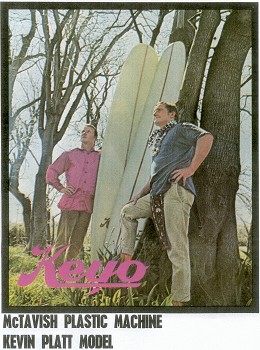 Bob McTavish Plastic Machine - Kevin Platt Model Keyo Surfboards 19 Sydenham Road, Brookvale, Phone: 93 1699 Surf
International,
Volume 1 Number 1, December 1967, page 4 Dale Surfboards: McTavish's Forms, circa 1968. Surf International Volume 1 Number 10 page 36. October 1968 ? |
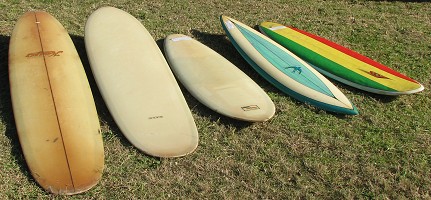 |
McTavish Quiver,
June 2207. From left to right: Keyo Dale Keyo Bluebird Sky |
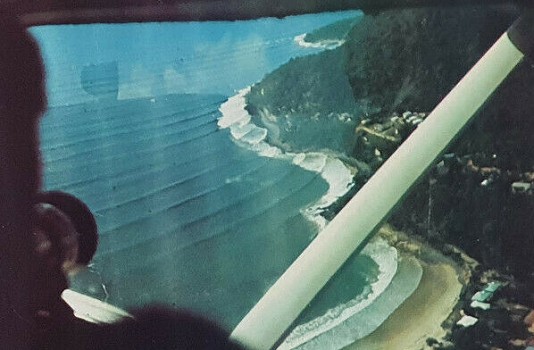 |
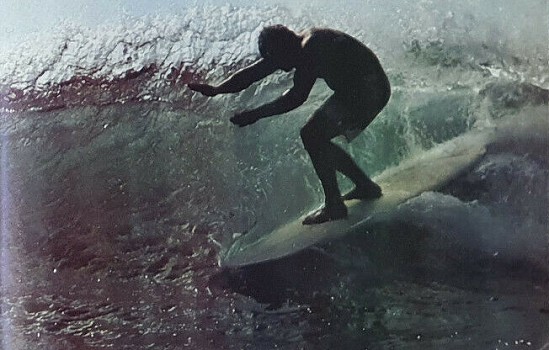 |
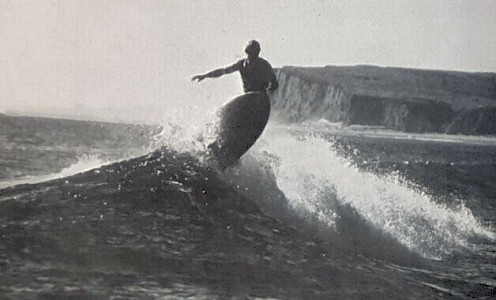
| 1967 Bob McTavish : On a bit of what's going on. Surfing World August/September 1967 pp 37. Performance and design circa 1967 (early-mid). Notes Brian (sic, Bob) Simmons, George Greenough, Midget Farrelly, Ted Spencer and Bobby Brown. Bob McTavish and Keyo Vee Bottom, 1967. Still from the film, The Plastic Fantastic Machine? |
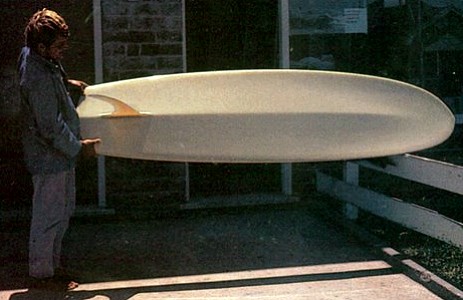 |
| Surf International Vol. 1. No. 3 February 1968. Page 27 [1] Bob McTavish is one of the best of the Australian surfers that are currently leading the sport of surfboard riding into the new realm of total performance. A combination of highly technical boards, and an uncanny insight into the moods of waves, combine to create McTavish the surfer. In the first of this sequence of three photographs, McTavish carves a long driving turn down the face of the wave. |
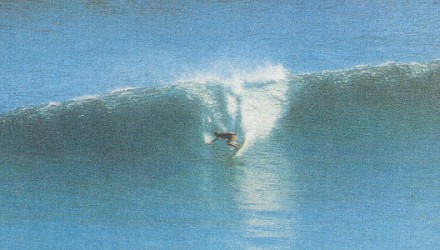 |
| [3] After rising high into the curl, as the wave becomes more critical, McTavish drops with the breaking wave to set up the last section of the ride. |
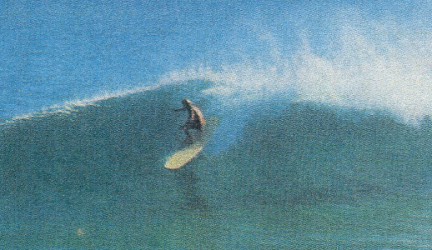 |
| [4] McTavish puts his board into a fantastic turn at the base of the wave. The fin, partially clear of the water is clearly visible. The whole side of the board is buried and it is on the rail, more than the fin that he makes the turn. |
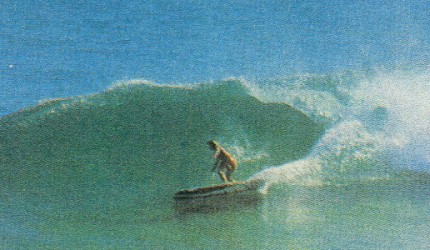 |
Another
photograph from the sequence [2],
published of the same edition of Surf International on page 34 |
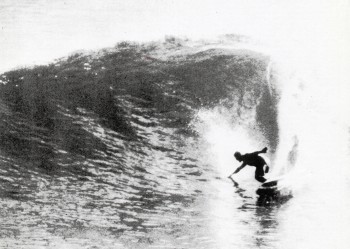 |
| 1968 Bob McTavish : Indian Head. Surf International Volume 1 Number 9, pages 42-45, November 1968. 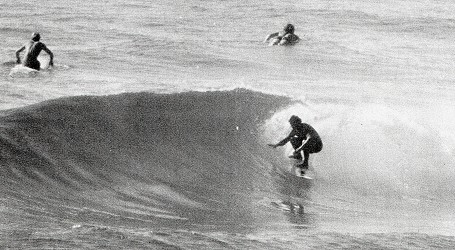 |
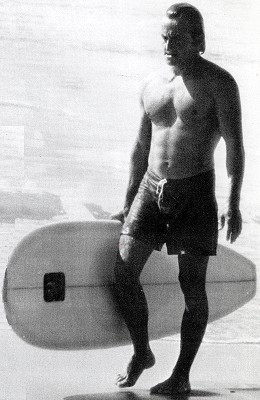 |
| 1968 Bob McTavish : My Surfboard. Surf International Vol. 1. No. 9 November 1968 page 46. Right:
Bob McTavish, Indian Head, 1968. page 45. |
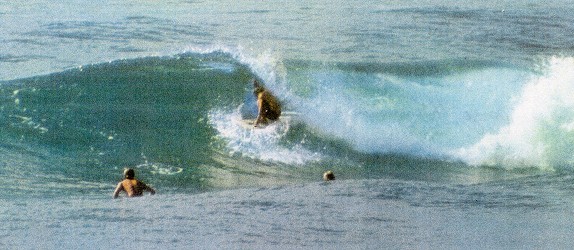 |
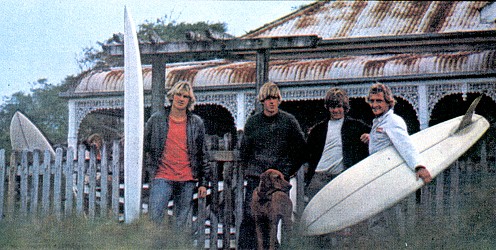 Chis
Brock, George Greenough, Dog, Garry Keyes andBob McTavish.
Hose of Surf and Wilderness "factory," Palmer's Island, Yamba (Angourie), 1969. Surfing World Volume 12, Number 5, 1969. |
McTavish Surfing Tools House of Surf Yamba NSW, 1969. Image courtesy of Adrian, June 2018. In response to an enquiry by Adrian in 2017, Bob McTavish wrote: That sweet Country Soul … I made it at Palmers Channel near Yamba in 1969. I shaped, Gary Keyes glassed it, Chris Brock sanded. I made the fin out of scrap. Watch George Greenough's Innermost Limits you’ll see the old farm house factory, and us surfing those boards. I have one too and value it highly.. Bob |
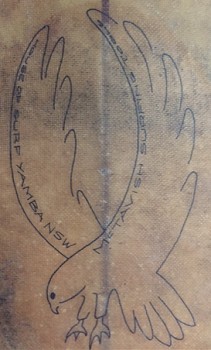 |
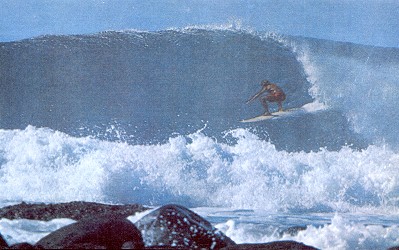 |
Wilderness Surfboards, Angourie, 1969. Surfing World, Volume 12, Number 5, 1969. Photograph : ? |
1970
Bob
McTavish : "Well, California again. Didn't expect it,
did enjoy it..."
SURF
INTERNATIONAL Vol 1 No. 6 1970? pp 8 to11.
Mat riding
Rincon with George Greenough, California.
Hawaii and
Sunset Beach on a Ryan Dotson Design 7'10" x 19".
| Morey-Pope
Surfboards (USA) 1965 Bob Cooper (USA) Blue Machine model, 1968 Bob McTavish Tracker model
1969 Bob McTavish Power Dude and Big Mac models |
|
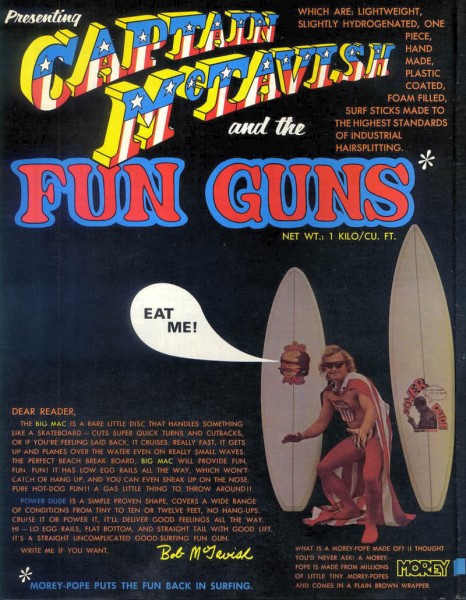
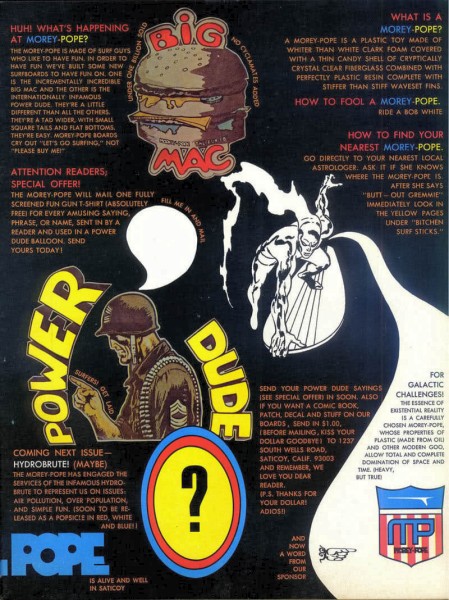
| In 2010, "Dave" pasted this comment by
Bob McTavish on swaylocks: Quite a treat seeing an old Dude.. I designed it in 1969 at Saticoy, east of Ventura, along with the Big Mac, two very hot boards for the time. Richard Deese was the shaper, and Morey did a many hundreds of them. The template was gunny, because the Big Mac was so hot-doggy and short, they were designed to be a pair. - Bob. Bob McTavish and
Morey-Pope Big Mac and Power Dude, 1970.
Power Dude design with Morey-Pope & Co. decal, blank marked B.M., 1971. 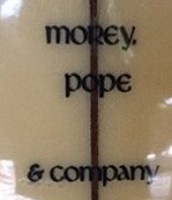
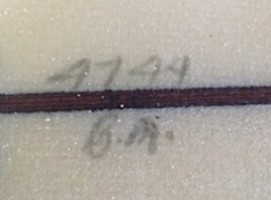 |
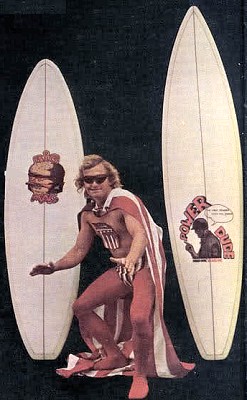  |
A regular contributor to Australian magazines and familiar with the work of their staff, McTavish probably had significant influence on the advertising copy and the decals; the artist, studio photographer and layout designer are unaccredited and unknown. Strongly influenced (a total rip-off?) by Marvel's Super Surfer and Captain America, the bold promotion of the stars and stripes of was topical and controversial, given the growing opposition to America's, and Australia's, ongoing conflict in Vietnam, further emphasised by the Power Dude decal. The ad is infused with irony and humour; Fun Guns, Capt. McTavish was actually an Australian, the amateurish costume (bare chest, red tights, and sunglasses), and the stance. Although adopting a classic riding pose, Bob is standing on his cape; a regular hazard avoided by all super-heroes and super-heroines. An early commercial recognition of the idea of a quiver, the boards were designed to be a pair, or rather two boards to cover a wide range of conditions, acknowledging that there was no ultimate perfect design for every wave. The Power Dude was a refined version of the square-tailed Tracker of the late-1960s, shifting the wide point back and refining the nose template; the Big Mac was a small wave board with a negative wide point and reminiscent of Dewey Weber's Pig board of the late 1950s. Ventura Surfshop
crew, William
Dennis Surfboards, Front Street, circa 1972.
Formerly the retail
outlet for Morey-Pope Surfboards, and later Karl
Pope's Wave corporation,
the Big Mac and the Power Dude were probably display left-overs from 1969. See: Ventura SurfshopIn a Surfer Tip in 1971, McTavish detailed the two alternative designs as Streaks and Slugs. Initially, the Big
Mac (McDonald-McTavish) was actually the smaller of
the two at about 6ft, the Power Dude plus 7ft.
The burger decal echoed Warhol's Pop Art concept of the product as artefact, famously explored in his Campbell's Soup series of 1962; in the mid-1980s Warhol revisited the forms and motifs of his work from the 1960s, producing his own Hamburger . Incidentally, in the early 1960s, in a series of plastic sculptures Claes Oldenburg created Floor Burger and Two Cheeseburgers, with Everything. The Power Dude decal is in the comic-book style of Roy Lichtenstein. It was rumoured that Morey-Pope was contacted by the legal representatives of Marvel Comics and McDonalds. Subsequently, the controversial decals disappeared from advertising and apparently were no longer laminated to the boards, although the names remained, if some what confusingly. There was now a little big Power Dude and a little Big Mac joined by the Fast Back Tracker, and all available from 5ft to 7ft. Notably, the hard-edged down railer Fast Back Tracker was designed for breakaway releases and side slips*. After brief period of popularity at the end of the 1960s, side-slipping disappeared from competitive surfing when it was effectively banned from the 1970 World Contest in Australia. See Merv Larson: The New Adam and Midget Farrelly : Side Slipper and World Contest, 1970. |
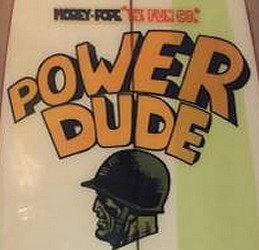 |
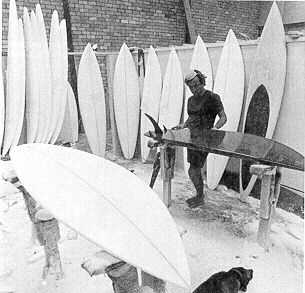 |
Bob
McTavish: Huzza Wuzza Tri-fin Bennett Surfboards, Brookvale. Tracks May 1972, page 14. |
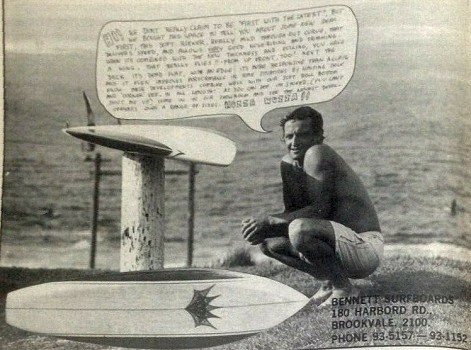 |
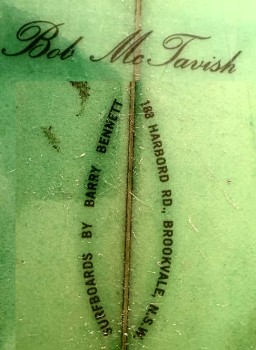 |
1977 Bob McTavish : Spoons 1977 Surfing World Volume 24 Number 4 January-February ? 1977, pages 64 - 65. 1977 Bob McTavish : Modern Malibu Surfer Vol 18 No.4 1977, pages 102 - 103. Bob
McTavish, electric planer and plywood templates.
Saffrons Boardshorts $7.99 Tracks Number 84 October 1977, page 6. 1978 Bob McTavish : Ace in the Hole : The Asymmetric Story. Seanotes August/Septerber 1978 pages 38 - 39. |
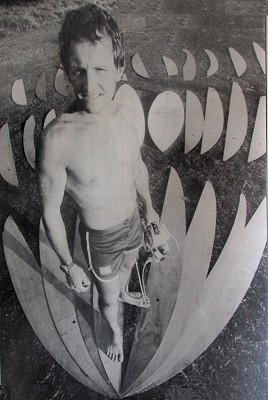 |
| Magazine Articles About
Bob McTavish 1. Eccentrics SW 2.Interview SW 1972 3.Paul Gross : in Surfer magazine 4. Australian Surfers Journal |
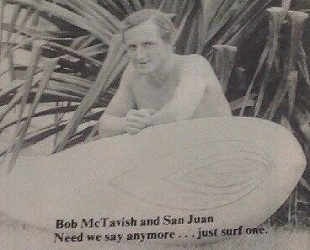 Tracks, May 1973.
|
| 2009
McTavish, Bob: Stoked! Hyams Publishing. PO Box 171 Huskisson, NSW 2540, 2009. www.hyams.com.au Hard cover, 431 pages, black and white photographs, Some of My Friends, Glossary, Index. Review Bob McTavish's enthusiasm for surfing, and life generally, permeate Stoked!, covering his surfing career up to 1968, which leaves open the possibility of a further volume covering the next 40 years. While the formative years in Queensland as a member of Caloundra Surf Life Saving Club are highly interesting, for the reader who has closely followed McTavish's numerous media contributions, many of the stories from the 1960s are extremely familiar. Indeed, in some cases their re-telling here seems to lack some of the freshness evident in the original versions. As expected, there are some minor errors in dates or spelling (Milner, not Millner, page 38) and a tendency to somewhat overstate the author's impact on the surfing industry. This is evident in the account of the Vee bottom board during 1967 (Part 8) - Midget Farrelly had already established the "lightweight" stringerless as an industry standard by 1966 and he played a major role in the radical reduction in board lengths. In 1973, McTavish wrote: "At the same time Midget's shop at Palm Beach was running stiff competition with us at Keyo's. As we'd cut 2" off, Midget would cut 4" off, then vice versa." Significantly, he rejects the commonly held myth that his and Nat Young's plus nine foot V-bottom surfboards taken to Hawaii in December 1967 initiated the Short Board Revolution (pages 383 to 396). |
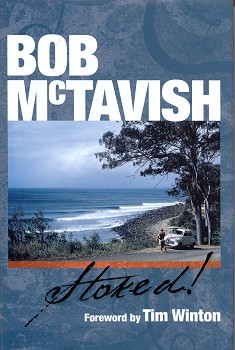 |


| home | catalogue | history | references | appendix |